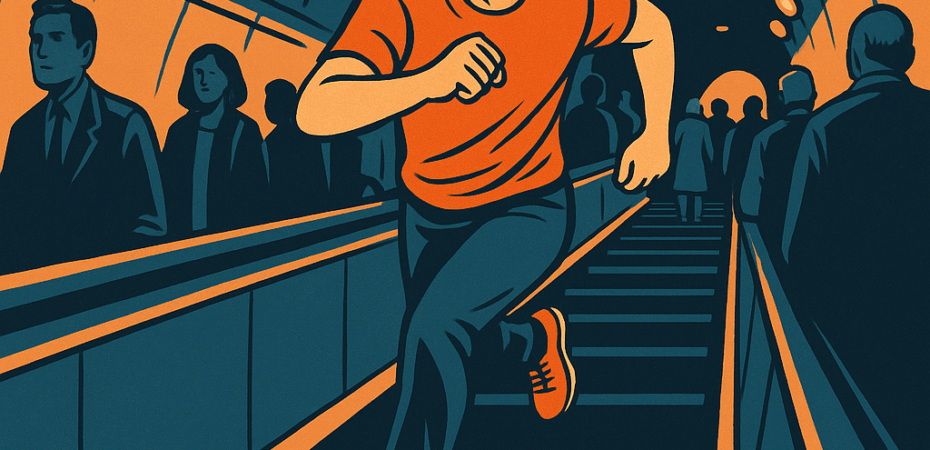Turning the Tide on Time—Keep Calm and Keep Swimming

Picture yourself floating down a broad, slow‑moving river. In the distance, you can hear a waterfall roaring —yep, that’s death. Let the current carry you, and You get closer and closer to the drop (ordinary aging). Start a casual dog‑paddle and you barely hold your place. switching to a strong breaststroke and racing the river’s draw—and boom: you’ve reached longevity escape velocity (LEV), adding healthy years quicker than the calendar can steal them. One splash‑friendly dream.
1 . Who first yelled “Swim harder!”
Biogerontologist Aubrey de Grey proposed the LEV idea in his 2004 paper “Escape Velocity: Why the Prospect of Extreme Human Life Extension Matters Now.” He argued that If we can push biomedical progress so that each calendar year adds > 1 extra year to remaining life expectancy, people who receive periodic “rejuvenation” treatments will outrun ageing indefinitely. He likens it to firing a rocket fast enough to leave Earth’s gravity [1]. Something like our swimmer.
2. How fast are we swimming today?
Globally, life expectancy has been creeping forward at roughly a quarter of a year per calendar year. Then COVID pushed us downstream: between 2019 and 2021, the world lost 1.8 years of average life expectancy, destroying almost ten years of advancement [2]. We’re gaining distance again, but right now we’re still hitting maybe 20–30 per cent of the speed we need to out‑swim the waterfall.
3. Turbochargers in the lab (new paddles and propellers)
- Senolytics—drugs (and soon vaccines) that hunt down “zombie” cells leaking inflammation. The classic dasatinib + quercetin combo showed promise in small human trials, and smarter, targeted molecules are paddling into Phase II studies [3]. If we can keep trimming the zombie load every few years, we can reduce chronic inflammation and tissue wear-and-tear and save more time.
- Gene‑ and RNA‑tuning: CRISPR has already cured a few blood disorders; scientists now play with “partial reprogramming” that rewinds cellular age in mice without turning them into tumours.
- AI‑powered drug discovery: Large models can suggest new anti-ageing drugs in a matter of weeks, saving years of lab work—but the long approval process still lies ahead.
- Supplement stampede: Over‑the‑counter “senolytic” capsules—fisetin, quercetin, whatever‑sounds‑botanical—fly off shelves, while doctors wave caution flags about weak evidence and dosing [4].
4. Do we actually reach LEV—and when?
Forecasts vary depending on your weather apps:
- Aubrey de Grey wagers on the mid‑2030s to early‑2040s, assuming money and politics don’t dry up the research stream.
- Futurist Ray Kurzweil bets on a similar 2030s window, riding exponential tech curves.
- Most mainstream gerontologists raise an eyebrow and say, “Come back in the 22nd century—biology is messy.”
Even when something works wonders in mice, it still has to face the twists of the human body, pass safety reviews, and come at a price the whole world can afford.
5. What can a regular carbon‑based swimmer do right now?
- Basics still rule: run, eat, sleep more than your phone.
- Stay curious: read actual studies before buying unregulated peptides from random web stores.
- Vote and donate wisely: credible longevity research needs cash and sensible regulation, not just billionaire hobby funding.
- Keep friends close: strong social ties add happy years faster than any bottle promising to “reset your Y chromosomes.”
6. The bigger‑than‑biology splash zone
- Money: If grandparents live to 120 and keep working, what happens to career ladders and pensions?
- Fairness: Do longevity upgrades stay first‑class‑only?
- Meaning: How many hobbies fit into four extra decades—and will we still dread Mondays?
LEV isn’t just a lab puzzle; it’s an everything puzzle, our biggest and maybe final puzzle, the fuzzle.
7. Final stroke
We’re not yet powering past the waterfall, but the labs are buzzing, money’s pouring in, …and it won’t be long before people are comparing longevity test results over coffee. Just keep paddling, keep laughing, and travel light—this river might carry us a whole lot farther than anyone ever thought.
References
[1] De Grey, A. D. N. J. “Escape Velocity: Why the Prospect of Extreme Human Life Extension Matters Now.” PLOS Biology, 2004.
[2] World Health Organization. “COVID‑19 eliminated a decade of progress in global life expectancy.” May 24 2024.
[3] Zhu H. et al. “Senolytics: from pharmacological inhibitors to immunotherapies.” npj Aging, 2024.
[4] New York Post. “These supplements can get rid of ‘zombie cells’ that speed up aging — but doctors have a warning.” Feb 19 2025.


